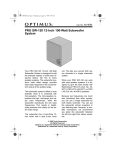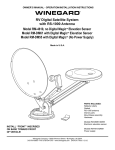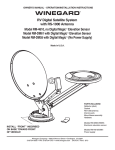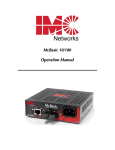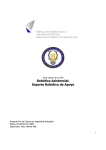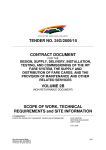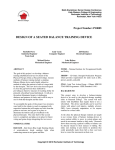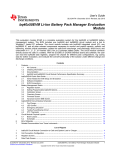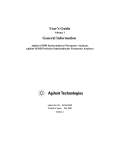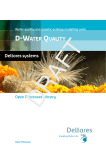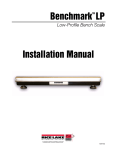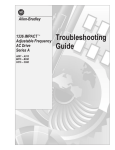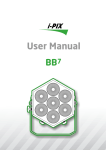Download CellSense Manual 1 st generation
Transcript
CellSense User’s Manual Cell Voltage Monitor (CVM) October 2007 Contents Introduction Application Technology CVM schematics CVM specifications Installation Assembly Connecting the powder supply Connecting the CAN bus Allocating a Node number Baptizing procedure Connecting the stack Connecting the alarm relay Connections in case of more stacks Basic settings Advanced settings and possibilities Message type : detailed or summary Extra idle time Stack ID Led and relay Time counters CVM/CAN protocol Software References CellSense User’s Manual June 2006 3 3 3 4 5 5 5 6 6 6 6 7 7 7 8 9 9 9 9 9 10 11 14 15 2/15/ Introduction Cell Voltage Monitor (CVM) has been designed to measure all individual cell voltages of a fuel cell stack. The measurements are processed into a summarizing message, that is sent over a serial connection to a system controller, allowing to react on decreasing cell voltages. Application This concept is meant to be part of a control and monitoring circuit of a commercial fuel cell stack. The accuracy and the rate of the measurements are based upon this target, resulting in a significant cost reduction compared to classic cell voltage measuring systems. The performance of the system allows to obtain polarisation curves of individual cells or to detect low cell voltages in an early stage. Detection of low voltages can be followed by e.g. increasing gas flows, or in worse cases, switching off the load. Possible advantages: • lower gas stochiometry (lower λ) • higher availability, better quality of electric power • less chance of damage • increased life expectancy • fast diagnosis in case of damage Technology A detailed description of the technology can be found in the patent text. The system consist of two components : the voltage scanning unit and the central unit. The voltage scanning unit (VSU) measures the voltages of 4 cells. Any number of VSUs are connected through a galvanic isolation to a common data bus and a voltage supply line. The central unit takes care of the data communication with the VSUs, the power supply to the VSUs and the communication to the outside world, e.g. via CAN bus. The central unit can pre-process the measured data, so that only relevant data will be sent, limiting the data stream on the communication bus and by that also the work load on the receivers of the data. The pre-processing is completely implemented in software and therefore it can be adapted according to the application. The pre-processing sends a CAN message with the maximum, the minimum and the average cell voltage and the corresponding numbers of the cells where the maximum and minimum voltage occur and it controls two digital outputs pointing out an alarm status. CellSense User’s Manual June 2006 3/15/ CVM schematics Data bus Power bus Stack VSU Main Controller COM PORT PWM Internal comm. port Figure 1 : Schematics CellSense User’s Manual June 2006 4/15/ CVM specifications Parameter Supply voltage Power consumption Measuring range Accuracy Resolution Conversion rate Maximum number of cells Galvanic isolation between cell groups and central unit Galvanic isolation over power supply Galvanic isolation of the CAN bus Table 1: Specifications Value 20..30 VDC 1 W + 50 mW / cell -0,1...1,1V ± 10 mV 2,5 mV 900 cells / sec. 270 300 VDC 1500 VDC 2500 VAC Installation Programming connector Alarm LED CAN bus NO Com NC Relay +24V GND Power spply Figure 2 : Connections Assembly The system is delivered in order to be mounted on a fuel cell stack and can be considered as a part of the stack. Fuel cells can generate dangerous voltages. In order to avoid dangerous situations, the assembly must be carried out when the stack has no voltage. The assembly has to be carried out by skilled persons able to detect this safe situation. The dimensions of the printed circuit board (PCB) fit to a stack with 73 – 76 cells. Smaller stacks down to 28 cells can be equipped with the same system, cutting off the PCB between two VSU’s: minimum 7 VSU’s have to be kept intact. The two long sides of the PCB have a strip (5 mm) in order to assemble the PCB on top of the stack. The assembly must guarantee protection against: CellSense User’s Manual June 2006 5/15/ * radiation/reception of EMI, also via cables * mechanical stress * contact or electric shock * isolation failure in case of high voltages, especially when connecting more stacks in series Connecting the power supply Power to the system is supplied by a 24 VDC isolated power supply or grid adaptor. The connection is on the terminals of the PCB. Several CVMs may be connected to one power supply provided isolation limits are not exceeded. Connecting the CAN bus The CAN bus is connected by a DB9 connector. The connections are according to the recommendations CiA DS 102. 1 2 3 4 5 6 7 8 9 CAN_L CAN_GND CAN_SHLD The power supply of the galvanic GND isolation of the CAN bus can be CAN_H passed from an external source over Figure 3 :DB9 CAN this connector. In this case the jumper bus connector CAN_V+ at the CAN interface should be removed. In the other case the galvanic isolation will be powered from the CVM and no supply lines should be connected. Allocate Node number The CVM communicates over a CAN bus with its own protocol that can coexist with CANOpen. This allows connecting several participants (nodes) on the bus, such as other CVM’s, invertors, PLCs, sensors, etc.. Every participant (node) receives a node number between 1 and 127. In order to adjust the node number of the CVM, a point to point CAN connection has to be made and the node number has to be adjusted following the CVM/CAN protocol (see lower). As soon as the CVM has received its node number it can be connected to a CAN bus The supplied LabView interface can be used to adjust the node number. Baptizing procedure Before connecting a stack every VSU has to receive an unique (within one CVM) address. This address is an increasing number between 0 and 220. The VSU of the first cell group (cell 1 to cell 4), receives the address 0, the VSU of cells 5 to 8 receive address 1, etc. Adjusting the addresses is called ‘baptizing’ and is necessary to be able to make the correct link between each VSU and its physical connection to the stack. CAN communication has to be active. Clear all existing addresses in the VSU’s (function code 9) and start the baptizing procedure (function code 7) Supply a voltage of 2,2 – 4,5 V between two terminals of the first VSU . As soon as this voltage has been measured by CellSense User’s Manual June 2006 6/15/ the VSU, this VSU receives address 0. This is reported over the CAN bus (function code 8), and the first VSU has been baptized. Move the voltage supply to the following VSU for baptizing. After each confirmation over the CAN bus the supply voltage can be moved to the next VSU. Scrupulously respect the physical sequence of the VSUs. If the last VSU has been baptized, the baptizing procedure should be stopped (function code 7) and one can start connecting the stack. In the CVM every cell has a shunt resistance of 100 Ohm. In the worst case the supply voltage has to have the capacity to deliver 45 mA (4,5 V / 100 Ohm), in the best case 8 mA (2,2 V / 300 Ohm) need to be delivered. The voltage source can be a 9V battery with , at least, a suitable resistance (470 Ohm in case of 8 mA). The accompanying LabView interface can be used for baptizing the VSU’s (‘Baptize’ tab); the progress of the process can be followed interactively. Figure 4: Baptizing Connecting the stack -stack +cell1 +cell2 +cell3 +cell4 +cell5.... Figure 5 :stack connections The negative terminal of the stack must be connected to the first connection (closest to the corner of the print) of the first VSU. This VSU has 5 connections. The remaining four connections are the positive terminals of the first four cells of the stack. All following VSU’s have four connections for the positive terminal of each of the four cells of a group of cells. Connecting the alarm relay The alarm relay switches if the voltage of at least one cell drops below a set value and remains low for several consecutive measurement cycles (function code 13 to 15). A NO CellSense User’s Manual June 2006 7/15/ (normally open) and NC (normally closed) contact are available. The operating mode of the relay can be programmed to : 1. be exited in case a. of fault b. of no fault 2. change state when a. a cell voltage becomes low only b. a cell voltage becomes low and an internal fault was detected 3. signal a low cell voltage when the lowest cell voltage a. drops below a fixed threshold b. deviates from the average cell voltage These options allow the user to set up the system and use the relay for fail-safe operation. Connections in case of more stacks Fuel cells connected in series can generate dangerous voltages, even if the stack that one is working on, has no voltage. In order to avoid dangerous situations the assembly has to be carried out if the complete installation has no voltage and has to be carried out by persons with the necessary knowledge to make sure that the work situation is safe. If several stacks are connected in series and each stack has its own CVM, differences in potential occur over the different CVM’s. The magnitude of these potential differences is a function of the number of stacks in series and can be present over the isolation of the power supply, the CAN bus and, potentially, the alarm relay. The user should take care of the fact that the different CVMs should not have the same potential via the power supply. In this case, each CVM needs its own galvanic isolated power supply. An individual adaptor with the corresponding isolation potential will be sufficient. Basic settings Before doing the first test at least the number of cells for a stack (function code 1) and the offset voltage of the A/D converters in the VSU’s (function code 6) have to be set. In case of a stack with 50 cells, one has to send following CAN message to the CVM: ID = 600 + NN set 50 cells func.c. 01h data 1 0 data 2 32h data 3 0 Table 2 : set the number of cells via the CAN bus Each A/D converter has an offset voltage that allows measuring negative voltages. This voltage is in principle 400 mV, but can vary slightly between different VSU’s. Therefore this offset can be individually programmed. It consists of the sum of two parts: a common part (e.g. 350 mV) and an individual part (e.g. 47 mV, 50 mV, 49 mV,….) for each VSU. The common part should be selected in a way that each individual part is between 0 mV and 250 mV. CellSense User’s Manual June 2006 8/15/ The CVM can be instructed to calculate the individual offsets. To do this it is required that all cell voltage inputs are at the same potential. If the CVM is equipped with cell shunt resistors, this can be achieved by leaving the terminals unconnected. In the other case all terminals should be shorted to each other. It is necessary to wait 10 seconds for the cell voltage inputs to stabilize at 0V. Then the CAN message can be sent to instruct the CVM to calculate and store the offsets. Initially the common part is set to 350 mV and all individual are automatically calculated by sending following two CAN messages to the CVM ID = 600 + NN set 350mV calculate offsets func.c. 06h 06h data 1 FFh FDh data 2 1 data 3 5Eh Table 3 : Set offsets via the CAN bus Additional settings are explained in more detail in the description of the protocol. The supplied Labview interface can be used to set the number of cells the offsets (‘Setup’ tab) Advanced settings and possibilities Message type: detailed or summary The CVM measures all cell voltages almost simultaneously (less than 300 µsec). The measurements are than read from the VSU’s. As soon as all measurements have been read (one cycle) a CAN message is sent with ID=180+node number containing the minimum, maximum and average cell voltage and the cells in which the minimum and maximum voltages occurred. It is also possible to obtain a detailed picture of all cell voltages by programming the CVM to send a message with all individual cell voltages after reading each VSU (function code 1). These messages have a lower priority, ID=280+node number. Retrieving these details significantly slows down the system and generates a lot of data traffic on the CAN bus. Extra idle time In order to limit CAN bus traffic or to slow down the conversion rate of the CVM, an additional delay of 2 to 425ms can be programmed after each conversion. The CVM will not perform any action during this delay. Stack ID Each CVM belongs to a stack. An individual identification of the stack and CVM can be stored in the CVM (function code 12) and can be read (function code 11). The maximum length of this identification is 7 characters. Led and relay A red LED and a relay are provided for detecting low cell voltages. The operation mode and the cell voltage for switching the LED and the cell voltage for switching the relay can be set each (function code 15) or read (function code 13 and 14). The LED operation is similar to the relay operation as explained in “connecting the stack” except that it CellSense User’s Manual June 2006 9/15/ changes state after only one error was detected. On the other hand the relay switches only if and error condition persists during a programmed number of consecutive cycles. A relay contact can be e.g. part of a emergency shut down circuit or can be part of the signal enabling the load. Time counters The CVM includes two time counters counting the seconds that the stack is operated under open circuit conditions and under load condition. These conditions are recognised by comparing the average cell voltage to two thresholds. Ucel_average > Uopen_circuit_threshold : the open-circuit counter increments Uoperation_threshold < Ucel_average < Uopen_circuit_threshold : the in-operation counter Ucel_average < Uoperation_threshold increments : no counter increments The counters can be reset or preset via the CAN bus interface. The counters are saved in permanent memory every 256 seconds or when Ucel_average drops below Uoperation_threshold. Interrupting the power supply to the CVM while the fuels cell stack is in operation may cause loss of maximum 256 seconds. Whenever the sum of the counters reaches approximately 5000 hours or any of its multiples, an memory refresh procedure should be executed. The user should request this procedure by sending an appropriate CAN message (function code 21) to the CVM at a convenient moment (e.g. after shutting down the fuel cell stack). The procedure needs 1 second to complete. While it is running, the CVM can not operate normally. The accompanying LabView interface can be used to set and read the stack ID (‘Stack ID’ tab), to set an read alarm levels (‘Alarms’ tab) and to set and read time counters (‘Hour counter’ tab). CellSense User’s Manual June 2006 10/15/ CVM/CAN protocol The protocol used by the CVM on the CAN bus can coexist with CANOpen. With CANOpen each node in the network requires an unique node number (NN) between 1 and 127. This is also the case for the CVM. The message IDs used by a CAN node, are derived from the NN (see next table). In addition one fixed message ID is used to set the NN of a node. Therefore this can only be done in a point-to-point connection. CAN ID direction, length en frequency Contents 0 Receive 2 bytes 180 + NN (hex) Send 8 bytes at the end of e cycle 280 + NN (hex) Send 8 bytes After reading of one cell group Send 8 bytes Set node number : Byte 0 : 10(hex) : program node number Byte 1 : NN for one CVM Send summary of cell voltages : Byte 0 : cell number met highest voltage Byte 1..2 : highest voltage [mV] Byte 3 : cell number met lowest voltage Byte 4..5 : lowest voltage [mV] Byte 6..7 : average voltage [mV] Send details of all cell voltages : Byte 0 : cell group to which data belongs Byte 1..4 : cell voltages as 4 x 12 bits [mV](2) Send status and settings : Byte 0 : function code Byte 1..7 : see next table Receive settings : Byte 0 : function code Byte 1..7 : see next table 580 + NN (hex) 600 + NN (hex) Receive 8 bytes Table 4 : Different CAN messages The messages with ID-180+NN and 280+NN can be compared with the PDOs defined in CANOpen. The other messages, 580+NN and 600+NN are comparable with SDOs. In these messages the first byte of the data block is reserved for a function code, that determines the contents of the remaining bytes of the data block. Next table specifies what function codes are defined and how to interpret the contents of the data block. Rows with <-- as direction (from CVM to PC or PLC) are related to messages with ID = 580+NN, the remaining are related to messages with ID = 600+NN. Function code (Byte 0) 0 status message 1 --> CVM PLC <-<-spontaneous in case of error set number of cells, data stream type and additional delay CellSense User’s Manual --> Contents of van byte 1..7(filled up with 00s) Byte 1 :failure code 0 = no failure 1 = no VSU found 2 = data line continuously high 3 = data line continuously low 4 = no data received or failure in data van 1 VSU Byte 2 : cell group (VSU) with last failure Byte 3 : number measured cell groups Byte 1..2 : number of cells in system Byte 3 : 0=send only min/max.. (ID=180+NN) 1=send each cell data (ID=180+NN en ID=280+NN) Byte 4 : additional delay after measurement cycle June 2006 11/15/ 2 2 request number of cells, data stream type and additional delay reply number of cells, data stream type and additional delay --> <-reply to function code 2 4 5 request Voffset reply Voffset 6 set Voffset 7 baptize VSUs --> 8 baptized VSU 9 reset all VSU to default request stack ID <-at detection of baptizing conditions --> 10 0Ah 11 0Bh reply stack ID 12 0Ch 13 0Dh 14 0Eh set stack_ID 15 0Fh set alarm trip cell voltage 16 10h 17 11h request software version reply software version 19 13h 20 14h set time counter thresholds request time counter thresholds reply time counter thresholds 20 14h request alarm trip cell voltage reply alarm trip cell voltage --> <-reply to function code 4 --> Byte 1..2 : number of cells in system Byte 3 : 0=send only min/max.. (ID=180+NN) 1=send each cell data (ID=180+NN en ID=280+NN) Byte 4 : additional delay after measurement cycle Byte 1 : cell group number (5) Byte 1 : cell group number (5) Byte 2..3 : Voffset Byte 4..5 : Vsupply in 0.01V Byte 1 : cell group number (5) Byte 2..3 : Voffset in mV Byte 1 : 0=stop procedure 1=start procedure Byte 1 : cell group number of baptized VSU Byte 1..4 : AAh 55h 33h CCh --> <-reply to function code 10 --> Byte 1..7 : ID in ASCII Byte 1..7 : ID in ASCII --> <-reply to function code 13 --> Byte 1..2 : min cell voltage for LED on [mV] Byte 3..4 : min cell voltage for relay on [mV] Byte 5 : number of failures before relay switches Byte 6 : alarm operating mode (4) Byte 1..2 : min cel voltage for LED on [mv] Byte 3..4 : min cell voltage for relay on [mv] Byte 5 : number of failures before relay switches Byte 6 : alarm operating mode (4) --> <-reply to function code 16 --> Byte 1 : major version number Byte 2 : minor version nummer Byte 1..2 : Vopen circuit threshold [mV] Byte 3..4 : Voperation threshold [mV] --> <-reply to function code 20 CellSense User’s Manual Byte 1..2 : Vopen circuit threshold [mV] Byte 3..4 : Voperation threshold [mV] June 2006 12/15/ 21 15h 21 15h request time counter values reply time counter values 22 16h set time counter values --> <-reply to function code 20 --> Byte 1 : counter number 1 = open circuit counter, 2 = operation counter Byte 1 : counter number Byte 2..5 : counter value in seconds Byte 1 : counter number Byte 2..5 : counter value in seconds Table 5 : protocol on the CAN bus (2) 4x12 bits refers to a compression method in which four 12bit numbers are concatenated into six data bytes (3) Cell groups are numbered between 0 en 220 (00h to DCh). (4) The alarm operating mode is a byte composed or interpreted as eight bits with these functions : bit 0 : relay coil excitation 0 = relay coil excited if fault 1 = relay coil excited if no fault bit 1 : relay fault definition 0 = cell voltage only 1 = cell voltage and internal function bit 2 : relay cell voltage fault definition 0 = compare to constant 1= compare to average cell voltage bit 3 : not used bit 4 : led on 0= led on if fault 1= led on if no fault bit 5 : led fault definition 0 = cell voltage only 1 = cell voltage and internal function bit 6 : led cell voltage fault definition 0 = compare to constant 1= compare to average cell voltage bit 7 : not used (5) Voffset consists of the sum of two components: a common part for all cell groups and an individual part for each cell group. Cell group number FFh refers to the common component. Cell group number FEh collectively refers to all individual parts. Cell group number FDh instructs the CVM to automatically calculate and store the individual offsets. CellSense User’s Manual June 2006 13/15/ Software The CVM contains following software : • microcontroller firmware on each VSU : o converts individual cell voltages o communicates with the main controller • microcontroller firmware on the main controller of the CVM o communicates with de VSUs o processes the data of the VSUs into easily interpretable information o communicates on the CAN bus o holds all measurements • LabView driver example (PC, Windows, LabView 7.1 required) o can be used as user interface to the CVM over the CAN bus for starting up, commissioning and for adjusting settings o can be used as a driver or as an example for data-acquisition code in Labview with the CVM The Labview interface consists of a number of tab sheets. The functionalities of the interface with the CVM are grouped per sheet. The relation to the earlier described functions and possibilities is unambiguous. The diagram (source code) can be used as-is or can serve as inspiration to build, if desired, your own interface or data-acquisition. Moreover the interface is an illustration of the protocol description that can be useful when programming of an interface for other hardware, e.g. a PLC. In order to communicate via the LabView interface with the CVM, first the node number of the CVM to which we want to connect, has to be set on the main screen. In this way one can communicate with one single CVM, even though several CVMs are connected to the same CAN bus. As soon as the node number has been set the functions on the sheets can be used and they relate only to the selected CVM. Selecting the node number Figure 6 : LabView interface example CellSense User’s Manual June 2006 14/15/ It is recommended not to set the CVM to sending individual cell voltages (detailed data stream type) for general use, especially in the case that several CVMs are connected to the same bus. The large amount of data will inevitable lead to overloading the CAN bus. References [1] NI-CAN Hardware and Software Manual, National Instruments Using CAN in LabView [2] http://www.can-cia.org/ Official CANOpen standards [3] http://atlas.web.cern.ch/Atlas/GROUPS/DAQTRIG/DCS/CANINFO/canproto.html Practical CANOpen standards [4] Controller Area Network, a Serial Bus System – Not Just for Vehicles, ESD gmbh CAN bus documentation: principle and operation CellSense User’s Manual June 2006 15/15/
















